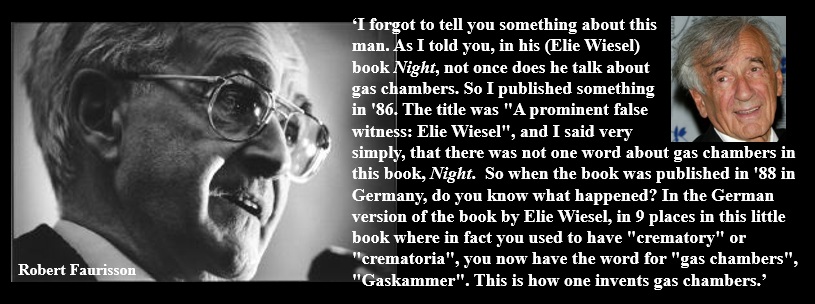
Faurissonís Exposure of the Holocaust Hoax
Based on a 4500-word comment by political analyst Luca K
This article consists mostly of important Faurisson quotations debunking the state-enforced conspiracy theory that 6 million Jews died in gas chambers on the orders of Hitler.
(SCROLL DOWN)
*
*
*
*
*
*
*
*
*
*
Pictures, captions and commentary by Lasha Darkmoon

[1]
— In 1951 the Jew Léon Poliakov, who had been part of the French delegation at the Nuremberg trial (1945-1946), stated his conclusion that we had at our disposal an overabundance of documents for all points of the history of the Third Reich, with the exception of one point alone: the “campaign to exterminate the Jews”. For this, he wrote, “No document remains,perhaps none has ever existed” (Bréviaire de la haine, Paris, Calmann-Lévy, 1974 [1951], p. 171; English version: Harvest of Hate, New York, Holocaust Library, 1979, revised and expanded edition)\.
Faurisson says: There is here an extraordinary concession to the revisionist case. In effect, such a formidable criminal undertaking supposedly conceived, ordered, organised and perpetrated by the Germans would have necessitated an order, a plan, instructions, a budget, … Such an undertaking, carried out over several years on a whole continent and generating the death of millions of victims, would have left a flood of documentary evidence. Consequently, if we are told that there perhaps has never existed any such documentary evidence, it is because the crime in question was not perpetrated.
In the complete absence of documents, the historian has no longer anything to do but keep quiet. L. Poliakov made this concession in 1951, that is, fifty-five years ago. However, it must be noted that, from 1951 to 2006, his successors have equally failed to find the least documentary evidence for the Holocaust.
Occasionally, here and there, we have witnessed attempts at making us believe in such or such discovery but each time, as will be seen below, the “discoverers” and their publicists have had to drop their claim.
[2]
[2] — In 1960 Martin Broszat, a member of the Institute of Contemporary History in Munich, wrote: “Neither at Dachau, nor at Bergen-Belsen, nor at Buchenwald were any Jews or other detainees gassed” (“Keine Vergasung in Dachau”, Die Zeit, August 19, 1960, p. 16)\.
Faurisson says: This sudden and unexplained concession is significant. At the Nuremberg trial the only homicidal gas chamber that the accusation ventured to show in a film had been that of Dachau, and the testimonies telling of alleged homicidal gassings in the three above-mentioned camps had been numerous. M. Broszat thus implicitly acknowledged that those testimonies were false. He did not tell us in what respect they were false. Nor did he tell us in what respect other such testimonies relating, for example, to Auschwitz, Majdanek, Treblinka, Sobibor or Belzec should, for their part, go on being deemed reliable.
In the 1980s, at Dachau, a sign indicated in five languages that the “gas chamber disguised as showers”, visited by the tourists, was “never used” as such. The revisionists had then asked in what respect the room could be termed a homicidal “gas chamber”, whereupon the Dachau Museum authorities took down the sign and replaced it with another on which, in German and English, can now be read:
“Gas chamber. This was the center of potential mass murder. The room was disguised as ‘showers’ and equipped with fake shower spouts to mislead the victims and prevent them from refusing to enter the room. During a period of 20 minutes up to 150 people at a time could be suffocated to death through prussic acid poison gas (Zyklon B).”
One will note the words “potential” and “could”, the choice of which attests to a fine bit of trickery: the information spawns in visitors’ minds the idea that the said “gas chamber” was effectively used for killing but, at the same time, it enables the museum to retort to revisionists: “We haven’t expressly said that this gas chamber was used for killing; we’ve merely said that it could be or could have been, at the time, used to kill a certain number of people”.
To conclude, in 1960 M. Broszat, without any explanation, decreed in a simple letter that no one had been gassed at Dachau; thenceforth, the Dachau Museum authorities, quite embarrassed, have tried, by means of assorted deceitful ploys varying over time, to fool their visitors into believing that, in this room, Jews had well and truly been gassed.
CONTINUE READING.....
http://www.darkmoon.me/2015/faurissons-exposure-of-the-holocaust-hoax/
